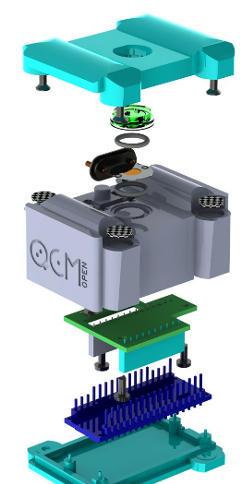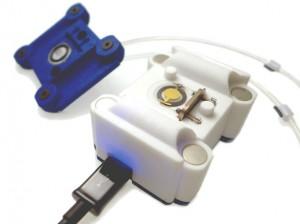When Novaetech designed openQCM, they knew their vision for the device would require extreme precision when it was executed.
A Quartz Crystal Microbalance, openQCM is an incredibly sensitive — and fully open-source — scientific device for applications in chemical and biological sensing, and it’s driven by a quartz sensor capable of measuring mass deposition down to 1 billionth of gram.
 Novaetech Srl is a spin-off of the National Institute for Astrophysics (INAF), and they are engaged in developing innovative sensors which boast high resolution and ultra high mass sensitivity. Their efforts are dedicated to the development of new generations of mass sensors based on quartz crystal microbalance and MEMS technologies, and they’ve already developed prototypes for dust aerosol detection and collaborated in a variety of international aerospace projects with NASA and the European Space Agency (ESA).
Novaetech Srl is a spin-off of the National Institute for Astrophysics (INAF), and they are engaged in developing innovative sensors which boast high resolution and ultra high mass sensitivity. Their efforts are dedicated to the development of new generations of mass sensors based on quartz crystal microbalance and MEMS technologies, and they’ve already developed prototypes for dust aerosol detection and collaborated in a variety of international aerospace projects with NASA and the European Space Agency (ESA).
 Those collaborations led to the development of “breadboards” used to detect dust and water in planetary environments like the MEDUSA instrument for future Mars exploration missions.
Those collaborations led to the development of “breadboards” used to detect dust and water in planetary environments like the MEDUSA instrument for future Mars exploration missions.
“The openQCM concept is inspired by the emerging movement of the open source hardware. It means that openQCM is a hardware whose design is made publicly available, in such a way that everyone can study, modify and distribute the hardware based on that design,” says Raffaele Battaglia of Novaetech.
One major challenge in developing open-source hardware is that such devices require funding to prototype and manufacture, and that’s why openQCM turned to 3D printing technology to keep costs low and quality high.
“Until now I have used 3D printing only for prototyping,” saysGlenda Torres Guizado, a designer for the openQCM project. “This time it will be useful to test it as an end product and see if it is suitable in the scientific precision sector.”
Using Sculpteo to print out the prototypes via the SLS process from OS Formiga P100, P110, P395, and P730, the team created the device’s parts – parts which required a precision of from 100 µm down to 60 µm.
 Battaglia, an astrophysicist and co-founder of Novaetech, has been involved in the development of mass sensors for planetary space missions and coordinated research projects in the biomedical and biological fields, and the Quartz Crystal Microbalance provided a perfect opportunity to use 3D printing technology.
Battaglia, an astrophysicist and co-founder of Novaetech, has been involved in the development of mass sensors for planetary space missions and coordinated research projects in the biomedical and biological fields, and the Quartz Crystal Microbalance provided a perfect opportunity to use 3D printing technology.
Quartz Crystal Microbalance systems take advantage of an intrinsic property of the quartz crystal: piezoelectricity, and QCM systems are widely used in various fields of research and industry.
Battaglia says that in the past, gaining access to such systems was difficult and building one might have required the investment of from a few thousand dollars up to several hundred thousand dollars.
Can you think of any other open-source scientific devices which would be too expensive for wide adoption without 3D printing technology? If you’ve know of such a product or have worked on such a project, please let us know in the 3D Printed Quartz Crystal Microbalance forum thread on 3DPB.com.
Read more at:http://3dprint.com/34734/openqcm-project/.
Note: Materials may be edited for content and length. For further information, please contact the source cited above.
Copyright © 2024 International Society of Bionic Engineering All Rights Reserved
吉ICP备11002416号-1









